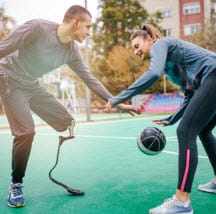
As you were working, one of the guards on the machines fell away. You knew you needed to reattach it, but with only a few more cuts to make, you decided to complete the job.
Moments later, it was every nightmare you’d ever had come true. Your hand was jerked into the machine, and you suffered serious lacerations to your fingers, hand and forearm. Fortunately, a coworker was nearby and shut off the machine.
Several of your fingers had to be amputated, and you have nerve damage throughout your hands and arm. This is a serious injury to live with, but it’s possible.
How can you adjust to living with an amputation?
To begin with, it’s not always easy to adjust to an amputation. You may be unfamiliar with getting dressed with only one hand or could have trouble doing normal daily activities.
The good news is that there are lots of things that you can do to adapt to an amputation. A few options include:
- Changing the kinds of clothing you wear to those without buttons or zippers that require two hands or fine motor skills in the hands
- Finding new work that does not require the use of fine motor skills in the affected arm. For example, if you were a typist in the past, you may want to switch to a job that is more verbal, if you’re able to return to work.
- Getting a little in-home help. Sometimes, having a few hours of assistance from someone in the health care field (or from someone you love) can help you get things done around the house that you might otherwise have trouble with due to the amputation.
Most people who go through amputations have to spend some time in the hospital as well as go through occupational and physical therapy. Occupational therapy is very important, because it helps you relearn how to do certain things that you could do easily in the past but that may now be harder. For example, if you still have two fingers on one hand and normal use of them, the occupational therapist may have ideas of how you can use that hand, along with the other, to get dressed or perform other needed skills like you could in the past, even if it’s more difficult at first.
Overall, living with an amputation is possible. It does take time to adjust, but there are people who can help.
